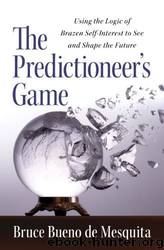The Predictioneer's Game: Using the Logic of Brazen Self-Interest to See and Shape the Future by Bruce Bueno de Mesquita

Author:Bruce Bueno de Mesquita [Mesquita, Bruce Bueno de]
Language: eng
Format: epub
ISBN: 9781588369086
Google: EMMMMUqGIboC
Amazon: 081297977X
Publisher: Random House Trade Paperbacks
Published: 2009-09-29T07:00:00+00:00
INCENTIVIZING IGNORANCE
Arthur Andersen was driven out of business by an aggressive Justice Department looking for a big fish to fry for Enron’s bankruptcy. Later, on appeal, the Supreme Court unanimously threw out Andersen’s conviction, but it was too late to save the business. Thousands of innocent people lost their jobs, their pensions, and the pride they had in working for a successful, philanthropic, and innovative company. Andersen’s senior management apparently was entirely innocent of real wrongdoing. Unfortunately, they nevertheless helped foster their own demise by not erecting a good monitoring system to protect their business from the misbehavior of their audit clients. In fact, that was and is a problem with every major accounting firm. In Andersen’s case, I know from painful personal experience how needless their sad end was.
Around the year 2000, the head of Andersen’s risk management group asked me if I could develop a game-theory model that would help them anticipate the risk that some of their audit clients might commit fraud (this is where my work related to the Sarbanes-Oxley discussion from a few chapters back began). As I have related, three colleagues and I constructed a model to predict the chances that a company would falsely report its performance to shareholders and the SEC. Our game-theory approach, coupled with publicly available data, makes it possible to predict the likelihood of fraud two years in advance of its commission. We worked out a way to identify a detailed forensic accounting that helps assess the likely cause of fraud—if any—as a function of any publicly traded company’s governance structure.
We grouped companies according to the degree to which our model projected that they were at risk of committing fraud. Of all the firms we examined, 98 percent were predicted to have a near-zero risk of committing fraud. Barely 1 percent of those firms were subsequently alleged to have reported their performance fraudulently. At the other end of our scale, about 1.5 percent of companies were placed in the highest risk category based on the corporate organizational and compensation factors assessed by the model. A whopping 85 percent of that small group of companies were accused by the SEC of committing fraud within the time window investigated by the model. This is a very effective system that produces few false positives—alleging that a company would commit fraud when it apparently did not—and very few false negatives—suggesting that a company would not commit fraud when it subsequently did.
Enron was one of the 1.5 percent of companies that we highlighted as being in the highest risk category. You can see this in the table on page 119, which shows our predictions for a select group of companies that eventually were accused of very big frauds. The table shows our assessment of the risk of fraud for each company each year. The estimates of interest are for 1997-99. These assessments are based on what is called in statistics an out-of-sample test. Let me explain what that means and how it is constructed.
Suppose
Download
This site does not store any files on its server. We only index and link to content provided by other sites. Please contact the content providers to delete copyright contents if any and email us, we'll remove relevant links or contents immediately.
| Anthropology | Archaeology |
| Philosophy | Politics & Government |
| Social Sciences | Sociology |
| Women's Studies |
Cecilia; Or, Memoirs of an Heiress — Volume 1 by Fanny Burney(32363)
Cecilia; Or, Memoirs of an Heiress — Volume 3 by Fanny Burney(31733)
Cecilia; Or, Memoirs of an Heiress — Volume 2 by Fanny Burney(31705)
The Great Music City by Andrea Baker(31079)
We're Going to Need More Wine by Gabrielle Union(18896)
All the Missing Girls by Megan Miranda(15325)
Pimp by Iceberg Slim(14181)
Bombshells: Glamour Girls of a Lifetime by Sullivan Steve(13921)
Talking to Strangers by Malcolm Gladwell(13120)
Fifty Shades Freed by E L James(13110)
Norse Mythology by Gaiman Neil(13109)
For the Love of Europe by Rick Steves(12126)
Crazy Rich Asians by Kevin Kwan(9109)
Mindhunter: Inside the FBI's Elite Serial Crime Unit by John E. Douglas & Mark Olshaker(9090)
The Lost Art of Listening by Michael P. Nichols(7353)
Enlightenment Now: The Case for Reason, Science, Humanism, and Progress by Steven Pinker(7078)
The Four Agreements by Don Miguel Ruiz(6532)
Bad Blood by John Carreyrou(6467)
Weapons of Math Destruction by Cathy O'Neil(6074)
